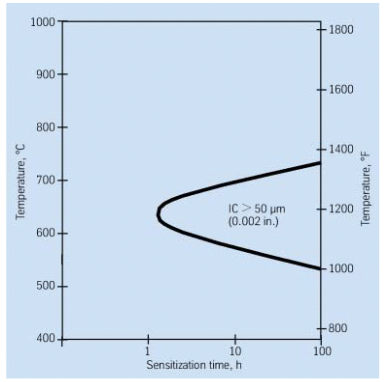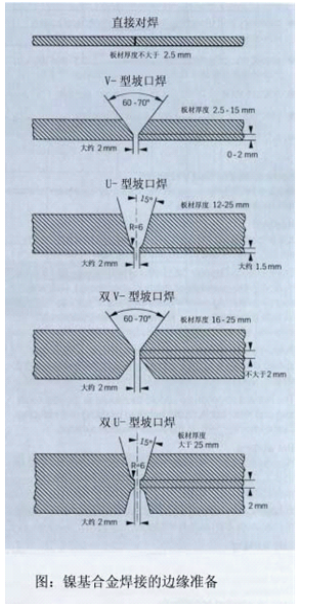Product classification

NS112 corrosion-resistant alloy
NS112 (N08811, 1.4876) is a fully austenitic low-carbon nickel-iron-chromium alloy that belongs to the same series as Incoloy 800, with cobalt content strictly controlled to below 0.01%. NS112 is resistant to many corrosive media. Its high nickel content provides excellent resistance to stress corrosion cracking under aqueous corrosion conditions. The high chromium content enhances its resistance to pitting and crevice corrosion cracking. This alloy exhibits good resistance to nitric acid and organic acid corrosion, but its corrosion resistance in sulfuric acid and hydrochloric acid is limited. Aside from potential pitting corrosion in halides, it shows good corrosion resistance in both oxidizing and non-oxidizing salts. It also demonstrates excellent corrosion resistance in water, steam, and mixtures of steam, air, and carbon dioxide. Applications include nitric acid condensers—resistant to nitric acid corrosion, steam heating tubes—exhibiting good mechanical properties, and heating element tubes—also with good mechanical properties. For applications in environments up to 500°C, the alloy is in an annealed state.
Classification:
Key words:
Superalloy | Inkenel | Hastelloy | Inkloy | Precision Alloy Series
Product Parameters
NS112
Material grade: NS112 corrosion-resistant alloy
US grade: UNS N08811
German grade: W.Nr.1.4876
1. Overview of NS112 (N08811, 1.4876) corrosion-resistant alloy:
NS112 (N08811, 1.4876) is a fully austenitic low-carbon nickel-iron-chromium alloy in the same series as Incoloy 800, with cobalt content strictly controlled to below 0.01%. NS112 can withstand corrosion from many corrosive media. Its high nickel content provides excellent resistance to stress corrosion cracking in aqueous environments. The high chromium content gives it better resistance to pitting and crevice corrosion cracking. This alloy has good resistance to nitric acid and organic acid corrosion, but its corrosion resistance in sulfuric acid and hydrochloric acid is limited. Except for possible pitting corrosion in halides, it has good corrosion resistance in oxidizing and non-oxidizing salts. It also exhibits good corrosion resistance in water, steam, and mixtures of steam, air, and carbon dioxide. Applications include nitric acid condensers—resistant to nitric acid corrosion, steam heating tubes—good mechanical properties, heating element tubes—good mechanical properties, etc. For applications in environments up to 500°C, the alloy state is annealed.
1. NS112 (N08811, 1.4876) corrosion-resistant alloy has the following characteristics:
(1) Excellent corrosion resistance in highly elevated aqueous media up to 500°C.
(2) Good resistance to stress corrosion.
(3) Good machinability.
2. Chemical composition of NS112 (N08811, 1.4876) corrosion-resistant alloy:
| C≤ | Si≤ | Mn≤ | P≤ | S≤ | Cr≥ | Ni≥ | Mo≥ | Cu≤ |
| 0.06-0.10 | 1.00 | 1.50 | 0.020 | 0.015 | 19.0-23.0 | 30.0-35.0 | - | 0.75 |
| Others | Al≤ | Ti≤ | Fe≤ | N≤ | Co≤ | Nb≤ | W≤ | V≤ |
| 0.15-0.60 | 0.15-0.60 | Remaining | - | - | - | - | - |
3. Physical properties of NS112 (N08811, 1.4876) corrosion-resistant alloy:
(1) Density: ρ=8.0g/cm3
(2) Melting temperature range: 1350~1400°C
| Temperature °C | Specific heat J/Kg K | Thermal conductivity W/mK | Resistivity μΩcm | Elastic modulus KN/mm2 | Thermal expansion coefficient 10-6/K |
| 20 | 440 | 10.8 | 112 | 195 | |
| 93 | |||||
| 100 | 462 | 12.4 | 114 | 190 | 14.1 |
| 200 | 488 | 14.1 | 118 | 185 | 14.9 |
| 204 | |||||
| 300 | 514 | 15.6 | 120 | 179 | 15.2 |
| 316 | |||||
| 400 | 540 | 16.9 | 124 | 174 | 15.6 |
| 427 | |||||
| 500 | 565 | 18.3 | 126 | 168 | 15.8 |
| 538 | |||||
| 600 | 590 | 19.6 | 126 | 161 | 16.0 |
| 649 | |||||
| 700 | 615 | 21.0 | 127 | 154 | 16.7 |
| 760 | |||||
| 800 | 655 | 23.2 | 128 | 142 | 17.2 |
| 871 | |||||
| 900 | 680 | 25.7 | 129 | 130 | 17.6 |
| 982 | |||||
| 1000 | 710 | 28.1 | 130 | 119 |
4. Mechanical properties of NS112 (N08811, 1.4876) corrosion-resistant alloy: (Minimum values for mechanical properties tested at 20°C)
The properties listed in the table below apply to NS112 alloy products after soft annealing (stabilization annealing) of specified specifications. Special properties for non-standard size materials can be provided according to specific application requirements.
Room temperature mechanical properties (minimum values)
| Product | Specification | Yield strength RP0.2 N/mm2 |
Yield strength RP1.0 N/mm2 |
Tensile strength Rm N/mm2 |
Elongation A50% |
Brinell hardness HB |
| Thin plate strip/cold rolled Plate/hot rolled |
0.5-6.4 | 240 | 265 | 585 | 30 | <=200 |
| 5-100 | 135-165 | |||||
| Bar Cold working Hot working |
1.6-64 | |||||
| 25-100 | ||||||
| >100-240 | 220 | 250 | 550 | 35 | ||
| Pipe Cold working Hot working |
64-240 | 180 | - | 530 | 30 | - |
| 5-100 | 240 | 265 | 585 | 30 | ||
| Condensers and heat exchangers | 16-76 |
High temperature mechanical properties (minimum values)
| Product | Yield strength RP0.2 N/mm2 | Yield strength RP1.0 N/mm2 | ||||||||||
| Temperature °C | 100 | 200 | 300 | 400 | 450 | 100 | 200 | 300 | 400 | 450 | ||
| Plate, strip, pipe | 205 | 180 | 170 | 160 | 155 | 235 | 205 | 195 | 185 | 180 | ||
| Bar | 190 | 165 | 155 | 145 | 140 | 220 | 190 | 180 | 170 | 165 | ||
5. ISO V-notch impact test of NS112 (N08811, 1.4876) corrosion-resistant alloy:
Room temperature average: Axial >=150J/cm2 , radial >= 100J/cm2 , time-temperature-sensitization curve.
6. NS112 (N08811, 1.4876) corrosion-resistant alloy condition stress value:
The high condition stress value that reaches 90% yield strength can be applied to situations that allow for slightly larger deformation. The permanent stresses caused by these stresses can lead to dimensional changes, so it is not recommended for flange and gasket connections.
7. NS112 (N08811, 1.4876) corrosion-resistant alloy metallographic structure:
The NS112 alloy has a stable face-centered cubic structure. The chemical composition and appropriate heat treatment ensure that corrosion resistance is not weakened by sensitization.
8. NS112 (N08811, 1.4876) corrosion-resistant alloy corrosion resistance:
NS112 is a general-purpose engineering alloy that has resistance to acid and alkali metal corrosion in both oxidizing and reducing environments. The high nickel content gives the alloy effective resistance to stress corrosion cracking. Its corrosion resistance is good in various media, such as sulfuric acid, phosphoric acid, nitric acid, and organic acids, as well as alkali metals like sodium hydroxide, potassium hydroxide, and hydrochloric acid solutions. The higher overall performance of NS112 is reflected in the diverse corrosive media of nuclear fuel dissolution systems, where sulfuric acid, nitric acid, and sodium hydroxide are processed in the same equipment.
II. Application range of NS112 (N08811, 1.4876) corrosion-resistant alloy:
NS112 is widely used in various industrial fields with operating temperatures not exceeding 550°C. Typical applications include:
1. Heating pipes, containers, baskets, and chains used in sulfuric acid pickling plants.
2. Seawater cooling heat exchangers, marine product pipeline systems, and pipelines in acidic gas environments.
3. Heat exchangers, evaporators, washing, and immersion pipes in phosphoric acid production.
4. Air heat exchangers in petroleum refining.
5. Food engineering.
6. Chemical processes.
7. Flame-retardant alloys for high-pressure oxygen applications.
III. Processing and heat treatment of NS112 (N08811, 1.4876) corrosion-resistant alloy:
NS112 is suitable for hot and cold processing, but due to its high strength, it requires high-power processing equipment. NS112 is suitable for welding using various convenient welding methods.
1. Heating of NS112 (N08811, 1.4876) corrosion-resistant alloy:
(1) The workpiece should always be kept clean before and during heat treatment.
(2) During heat treatment, it should not come into contact with sulfur, phosphorus, lead, and other low-melting-point metals, as this can damage the material's properties. Care should be taken to remove contaminants such as marking paint, temperature indicating paint, colored crayons, lubricants, and fuels.
(3) The lower the sulfur content in the fuel, the better. The sulfur content in natural gas should be less than 0.1%, and in heavy oil, it should be less than 0.5%.
(4) Considering the need for temperature control and cleanliness, it is best to conduct heat treatment in a vacuum furnace or gas-protected furnace.
(5) Heating can also be done in a box furnace or gas furnace, but the furnace gas must be clean and preferably neutral to mildly oxidizing. Fluctuations between oxidizing and reducing conditions in the furnace gas should be avoided, and the heating flame should not be directed at the workpiece.
2. Hot processing of NS112 (N08811, 1.4876) corrosion-resistant alloy:
(1) The hot processing temperature range for NS112 is 1200°C to 900°C, with cooling methods being water quenching or rapid cooling between 760°C and 540°C. Hot bending should be performed between 1150°C and 1000°C.
(2) To achieve optimal corrosion resistance and creep resistance, annealing treatment should be performed after hot processing.
(3) The material can be directly placed into a furnace heated to 1200°C, with a holding time of 60 minutes for every 100mm thickness. After sufficient holding time, it should be quickly removed from the furnace and hot processed within the specified temperature range. When the material temperature drops below the hot processing temperature, it needs to be reheated.
3. Cold processing of NS112 (N08811, 1.4876) corrosion-resistant alloy:
(1) The work hardening rate of NS112 is greater than that of austenitic stainless steel, so care must be taken in selecting processing equipment. The cold-processed material should be in an annealed state, and intermediate annealing should be performed during cold processing.
(2) If the cold processing amount exceeds 10%, the workpiece needs to undergo soft annealing treatment before use.
4. Heat treatment of NS112 (N08811, 1.4876) corrosion-resistant alloy:
(1) The soft annealing treatment temperature range for NS112 is 920°C to 980°C, with the optimal treatment temperature being 950°C.
(2) To achieve the best corrosion resistance, water quenching should be used for cooling, and rapid air cooling can also be used for materials with a thickness of less than 1.5mm.
3. During the heat treatment process, the aforementioned cleanliness requirements during heating must be followed.
5. Deoxidation and acid pickling of NS112 (N08811, 1.4876) alloy:
(1) The adhesion of surface oxides and welding slag around the weld of NS112 is stronger than that of stainless steel. Both mechanical and chemical methods can be used, but when selecting mechanical methods, care should be taken to avoid methods that may cause metal contamination or surface deformation.
(2) Before acid pickling with HNO3/HF mixed acid, careful grinding or salt bath pre-treatment must be performed to break the oxide film.
6. Machining of NS112 (N08811, 1.4876) alloy:
NS112 must be machined after annealing heat treatment. Due to the material's work hardening, it is advisable to use cutting speeds lower than those for low-alloy standard austenitic stainless steel and to use heavy re-entry cutting to machine below the cold-work-hardened surface.
7. NS112 (N08811, 1.4876) alloy welding:
NS112 is suitable for any traditional welding process, such as tungsten electrode inert gas shielded welding, plasma arc welding, manual sub-arc welding, metal inert gas shielded welding, melting electrode inert gas shielded welding, and gas shielded arc welding. Welding of NS112 must be performed in the annealed state, and the surface must be cleaned of stains, dust, and various markings. Low heat input should be used, with interlayer temperatures not exceeding 150°C. No pre-welding or post-welding heat treatment is required.
8. NS112 (N08811, 1.4876) alloy cleaning:
Remove scale, oil stains, and various markings, and clean the base metal and filler alloy (such as welding rods) in the welding area with acetone. Note that trichloroethylene (TRI), perchloroethylene (PER), and tetrachloride (TETRA) should not be used.
9. NS112 (N08811, 1.4876) alloy edge preparation:
It is best to use machining, such as turning, milling, or planing. Plasma cutting can also be used; if the latter is chosen, the cut edge (welding surface) must be ground clean and smooth, allowing for no overheating during finishing. The area of the base material on both sides of the weld seam, about 25mm wide, should be ground to expose bright metal.
10. NS112 (N08811, 1.4876) alloy bevel angle:
Compared with carbon steel, the physical properties of nickel-based alloys and special stainless steels are characterized by low thermal conductivity and high expansion coefficients. These characteristics must be considered during the preparation of the welding bevel, including widening the bottom gap (1-3mm). Due to the viscosity of the molten metal, a larger bevel angle (60-70°) should be used during butt welding to compensate for material shrinkage.
11. NS112 (N08811, 1.4876) alloy arc initiation:
The arc should not be initiated on the surface of the workpiece but on the welding surface to prevent corrosion at the arc initiation point.
12. NS112 (N08811, 1.4876) alloy welding process:
NS112 is suitable for any traditional welding process with the same material or other metals, such as tungsten electrode inert gas shielded welding, plasma arc welding, manual sub-arc welding, metal inert gas shielded welding, and melting electrode inert gas shielded welding, among which pulsed arc welding is the preferred option. When using manual arc welding, it is recommended to use a mixed shielding gas of (Ar+He+H2+CO2).
Welding of NS112 must be performed in the annealed state, and a stainless steel wire brush should be used to clean stains, dust, and various markings. When welding at the root of the weld seam, to achieve the best root weld quality, operations must be very careful (argon 99.99), so that no oxides are produced after completing the root welding. The color produced in the heat-affected zone during welding should be brushed off with a stainless steel brush while the weld area is still hot.
13. Recommended welding materials for NS112 (N08811, 1.4876) alloy:
Welding rod: ENiCrFe-3, welding wire: ER NiCr-3
Previous Page
Next Page
Previous Page
NS333 corrosion-resistant alloy
Next Page
Related Products
Product Consulting
Leave your contact information to get a free product quote!







